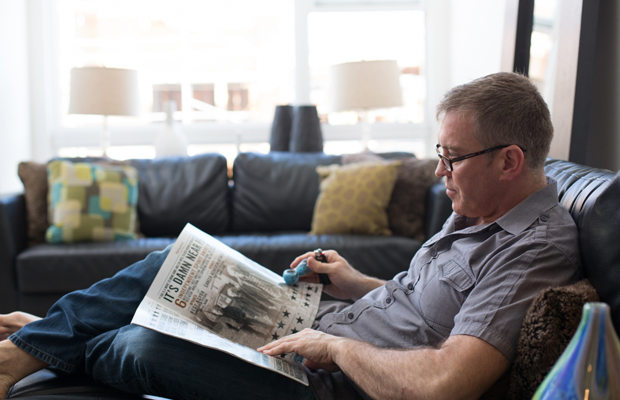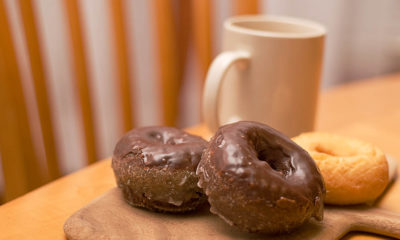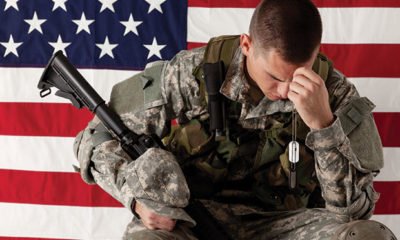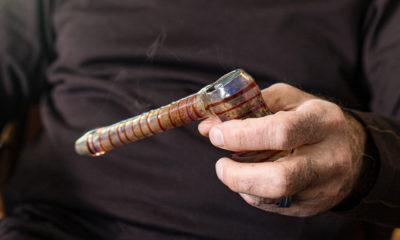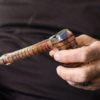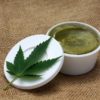The People’s Medicine: How Legalization Improves America’s Healthcare
As the laws continue to change, the medical establishment is being increasingly confronted with the efficacy of cannabis — the people’s medicine.
In the heart of Denver, the newly-minted marijuana capital of America, doctors from around the nation bared unseasonable late-summer frost to attend the Marijuana for Medical Professionals Conference. The event targeted medical professionals with one thing in common—a desire to know more about cannabis medicines as the substance is propelled out of the realms of early 20th-century “reefer madness” and into popular use as a highly-lucrative, 21st-century panacea.
On the top floor of the 100-year-old former Masonic temple, a cascade of doctors, a virtual “who’s who” of cannabis science, gathered in the large auditorium. Dr. Raphael Mechoulam—the Israeli researcher who isolated and identified ∆-9 tetrahydrocannabinol (THC) and cannabidiol (CBD) in the early 1960s— and Dr. Lester Grinspoon, long-time American cannabis researcher, professor emeritus in psychiatry at Harvard Medical School and author of “Marihuana Reconsidered” were among the attendees.
Over the course of the three-day conference, it became clear that the doctors with less exposure to cannabis are still struggling with the concept of botanical medicine and are clinging to the stigma-driven notion that there must be a downside. Although the laws are changing quickly, doctors are moving slowly and there’s a huge information gap to bridge before it becomes the medical establishment’s medicine too.
The most poignant and defining moment of the event came during a presentation by the founder of the American Cannabis Nurses Association (ACNA), a national organization of registered nurses with the mission to “advance excellence in cannabis nursing practice through advocacy, collaboration, research and policy development.”
“Cannabis, to me, in nursing is probably one of the most valuable tools I could have,” said ACNA President Mary Lynne Mathre, RN, MSN, while speaking at the conference about cannabis as a tool for clinical harm reduction. “Why do we insist that this pass every test of safety before we can have it? We give chemotherapy, which is designed to hopefully kill the cancer but it could also kill the person, but the patient has a choice for that.”
Mathre’s statements, while rooted in both available science and first-hand experience, still rubbed some doctors the wrong way, particularly a long-time OBGYN from New York.
“I was very impressed yesterday by all these wonderful and glorious things marijuana has done going back centuries, but then I happened to come across a review article in The New England Journal of Medicine, just published in June 2014 and the title of the article — which I recommend to everyone — is Adverse Health Effects of Marijuana Use. The article is by Dr. Volkow—”
The doctor was abruptly cut off by uncoordinated choruses of “bias” from other doctors in the auditorium. Dr. Nora Volkow is the director of the National Institute of Drug Abuse (NIDA).
After a careful analysis of the overt bias presented in studies produced by NIDA, Mathre concluded, “Stop looking at marijuana, start looking at cannabis.”
While Mathre may have been referring to adjusted online search terms to find more useful studies proving her points, the statement is evident of the shift in thinking required to understand marijuana as a medicine. The term “medical marijuana” is so loaded with cultural stigmas that any use of it as a medicine is wildly irresponsible to doctors indoctrinated in FDA regulations and double-blind placebo controlled studies. The term “medical cannabis” is not based in slang, but rather science and taxonomy. An understanding of the whole plant as not just an intoxicating drug, but also a medicine, vitamin and food must be achieved to truly understand the capabilities of cannabis medicines.
“The doctor at the conference who wanted more ‘balanced’ research was trying to make a point with an article he found on studies showing some harmful effects of cannabis,” Mathre said after the conference. “Per [Volkow’s] job description she can only study and discuss the harmful effects of cannabis. Of the tens of thousands of studies on cannabis, there may be a handful of studies that show some negative effects but they are few and not very harmful compared to so many prescription medications.”
Mathre adds that the majority of healthcare professionals have never heard of the endocannabinoid system because it is not taught in medical schools.
While there are established guidelines to dictate which substances are classified as medicines, foods, drugs or vitamins, those guidelines are often more political or financially incentivized than based in verifiable science. Although cannabis is truly efficacious as all of the above, it’s perceived in the medical community to be a powerful, addicting substance with no accepted use whatsoever.
Stigma Associated with Cannabis
Patients have been ahead of the medical establishment for years. Yet, for fear of recreational drug abuse, doctors have more often than not dismissed the notion that marijuana could be medicine. Recent studies have shown the stigma associated with cannabis use has impaired its understanding as a medicine.
“Medical cannabis straddles institutional boundaries between healthcare systems and their logics. Culturally, cannabis remains closely associated with recreational use and with stereotypes of its users,” says Dr. Michelle Newhart, author of the 2012 study From Getting High to Getting Well: Medical Cannabis Use Among Midlife Patients in Colorado. “As long as medicalization is incomplete, claims that medical cannabis use and the medical patient identity are legitimate remain in contest with nonmedical frames.”
Newhart’s study looks specifically at the stigma of cannabis and the effects on mid-life patients. She posits that because simply trying cannabis as a medicine means altering one’s identity, one is forced also to identify with the stigma and stereotypes as well. One need not alter their identity to accept pharmaceutical drug use.
The notion that drugs are inherently good or bad stems from the theory of pharmacologicalism, which values synthesizing and isolating individual compounds to treat individual symptoms. Cannabis is proven most efficacious as a whole-plant medicine, making it near impossible to be approved by the FDA and prescribed as a medicine, regardless of its drug schedule status.
Although the science used to place drugs in the categories of good and bad has largely been disproven, it’s still the prevailing theory that dictates drug policy today. Richard DeGrandpre, author of “The Cult of Pharmacology” argues that because drug science has been presented to the public as “technical and intimidating” it has allowed disproven science to prevail.
“This was a significant achievement, especially given the fact that the modern cult of pharmacology emerged alongside a diverse array of empirical findings that flatly contradicted it,” says DeGrandpre. “Most of these findings were ignored simply because they made no sense in light of the public attitude: some drugs were obviously good while others were clearly evil.”
Pharmacologically speaking, cannabis probably should be labeled as GRAS, or “generally recognized as safe,” because it has a very low potential for dependency or abuse and it’s nearly impossible to die of a cannabis overdose. But, looking at the simple pharmacology of cannabis only paints half the picture.
As DeGrandpre explains, the pharmacology of a drug doesn’t inherently determine its abuse potential. For instance, over half of Americans over the age of 18 say they drink coffee daily. While caffeine is the active ingredient found in whole-bean coffee that’s responsible for the plant’s effects as a stimulant, the ritual drinking of coffee is more addicting than the caffeine itself. Caffeine pharmacologically reinforces the coffee addiction by providing a reward — the caffeine buzz — after the ritual has been performed and the drug consumed.
Ritual coffee drinkers, however, are not arrested, stigmatized and cast out of mainstream society for their addiction because coffee never held its primary identity as a counterculture drug. Cannabis is viewed through the damaging lens of recreational use, even if that recreational use isn’t at all damaging to the humans who use it.
A Healthcare Revolution
“What does a healthcare revolution look like?” asked Michelle Sexton, ND, a naturopathic doctor addressing the conference on the topic of cannabis as an adaptogenic herb.
Sexton advanced her slide and the faces of about 15-20 epileptic children appeared on the screen.
“I want to know what the people know. Cannabis is the people’s medicine,” said Sexton. “What we know about [cannabis to treat] childhood epilepsy is all based on patient-reported outcomes at this point, now they are proving it after the fact.”
Doctors face overwhelming stigma when trying to study the effects of cannabis in their patients. Take, for example, the story of Dr. Sue Sisley, who also presented in Denver. Sisley is the director of the first-ever FDA-approved study on whole-plant cannabis as a treatment for PTSD, specifically in combat veterans. After the study made national headlines, it made international headlines when Sisley was promptly terminated from her job at the University of Arizona.
Sisley was addressing the conference on the thirteenth anniversary of the attacks on Sept. 11, 2001, which initiated the Afghanistan and Iraq Wars. She says that combat veterans of these wars are committing suicide at the astounding rate of 22 a day. She says as a doctor, she is partially to blame.
“The drugs we have for PTSD are fairly useless. That’s the sad thing, we don’t have a lot of treatment options,” says Sisley. “You have vets drowning in pills and I am a part of that. I am part of that problem. I have put so many veterans on every FDA-approved medicine on the market and in the end what they disclosed to me was that they have been finding ways to use marijuana successfully to manage their PTSD. I tried to dismiss it, but I realized we have a duty to these veterans to study this plant rigorously and understand what that is.”
Sisley’s study has become so “radioactive” as she puts it, that she has spent nearly three months trying to find a university that will let her conduct the research. But even if she finds a research institution that will take her, she could be waiting for NIDA to supply the weed indefinitely.
NIDA is the only provider of marijuana for FDA-approved studies, which Sisley and other cannabis researchers have decried is low-quality, not representative of the cannabis available in legal markets and is so low in THC (about six percent) it’s hardly relevant.
Still, FDA-approved studies are necessary to make a drug available by prescription to the general public, for any condition. Sisley says PTSD is a crisis, with 25 percent of returning combat veterans receiving the diagnosis and an untold number of others who suffer but are undiagnosed.
“We started to see a surge of veteran activism we have never seen before. We have 600,000 vets in Arizona and these guys started to come together,” said Sisley. “Veterans realize they are a legitimate political constituency and they are starting to behave that way.”
Similarly, medical and recreational cannabis users have, like combat veterans, become a political constituency that’s a force to be reckoned with, moving pro-cannabis legislation forward all across the nation.
In the combined 16 years of Presidents Bill Clinton and George W. Bush’s administrations, the first 12 states passed medical cannabis legislation. In President Obama’s first six years 11 more states and Washington D.C. have gone medical, two have passed recreational legalization and 11 more have passed restrictive high-CBD extract legislation specifically for children with epilepsy.
Do you think medical cannabis improves American health care? Let us know below.
Originally published in issue 13 of Cannabis Now.



